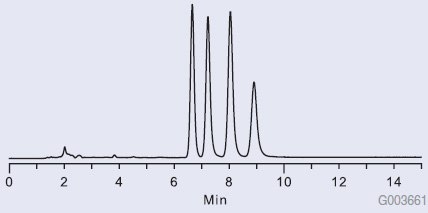Polar Compound Retention using Aqueous Normal-Phase (ANP/HILIC) Chromatography
Wayne Way
Reporter EU Volume 24
Section Overview
- Introduction
- Benefits of ANP/HILIC Separation
- Method Considerations
- HPLC Columns for ANP/HILIC
- Related Product
Introduction
Aqueous Normal-Phase (ANP) Chromatography, frequently referred to as Hydrophilic Interaction Liquid Chromatography (HILIC), is a variation of normal-phase chromatography with the distinction that one of the major components of the mobile phase is water. Typical eluents of ANP consists of 50-95% acetonitrile in water or an aqueous buffer. The high volatility of the eluent makes ANP LC-MS friendly where one can realize a dramatic increase in sensitivity compared to reversed-phase chromatography. A requirement for ANP is a polar stationary phase. Common phases include bare silica, fl uorinated phases such as Discovery® HS F5, cyano, diol, and even certain phenyl phases such as the Ascentis® Phenyl.
Many classes of polar compounds can be retained in ANP. These include polar neutrals, polar acids, and polar and non-polar basic amines. Both polar and ionic interactions appear to contribute to retention and selectivity in this mode of chromatography. HILIC retention can be simply described as the partitioning of a polar analyte into and out of an absorbed water enriched layer on the surface of the column. On the other hand, charged polar analytes can also undergo ion-exchange with the silanol groups on the surface. It is important to understand that either mechanism can dominate depending on the analyte and the mobile phase conditions.
Benefits of ANP/HILIC Separation
- Retain polar compounds that are too water soluble to be retained by reversed-phase chromatography
- Achieve complimentary selectivity to reversed-phase chromatography
- Gain enhanced sensitivity in mass spectrometry
- Facilitate recovery of preparative chromatography fractions due to high-volatility mobile phase
Biogenic amines is one class of compounds that can benefit from the use of ANP chromatography. Shown in Figure 1 is the analysis of four biogenic amines utilizing the Ascentis® Si column under ANP conditions. These small, polar compounds can be diffi cult to analyze by traditional reversed-phase chromatography utilizing C18 or other hydrophobic columns.

Figure 1.Separation of Biogenic Amines on Ascentis® Si (581512-U)
- Tyramine (50 µg/mL)
- Dopamine (50 µg/mL)
- Epinephrine (50 µg/mL)
- Levodopa (50 µg/mL)
| column: | Ascentis® Si, 15 cm x 4.6 mm I.D., 5 µm particles (581512-U) mobile phase: 15:85, 0.1% ammonium acetate in water (pH unadjusted): 0.1% ammonium acetate in acetonitrile |
| temp.: | 35 °C |
| flow rate: | 1 mL/min |
| det.: | UV at 280 nm |
| injection: | 10 µL |
| sample: | as indicated in 0.1% ammonium acetate in 10:90, water: acetonitrile |
Method Considerations
A consideration when using ANP chromatography is that many features are the opposite of reversed-phase chromatography. For example, add more organic solvent to the mobile phase to increase retention. Run gradients from low aqueous content to high aqueous content. Dilute samples with the organic solvent, not water. Finally, ionexchange can be a dominant mechanism, so adjusting buffer pH and ionic strength can have a dramatic effect on retention.
HPLC Columns for ANP/HILIC
Supelco offers four phases suitable for ANP chromatography. Each phase will perform differently in ANP chromatography but the following table provides a guide to get started.
Related Product
如要继续阅读,请登录或创建帐户。
暂无帐户?